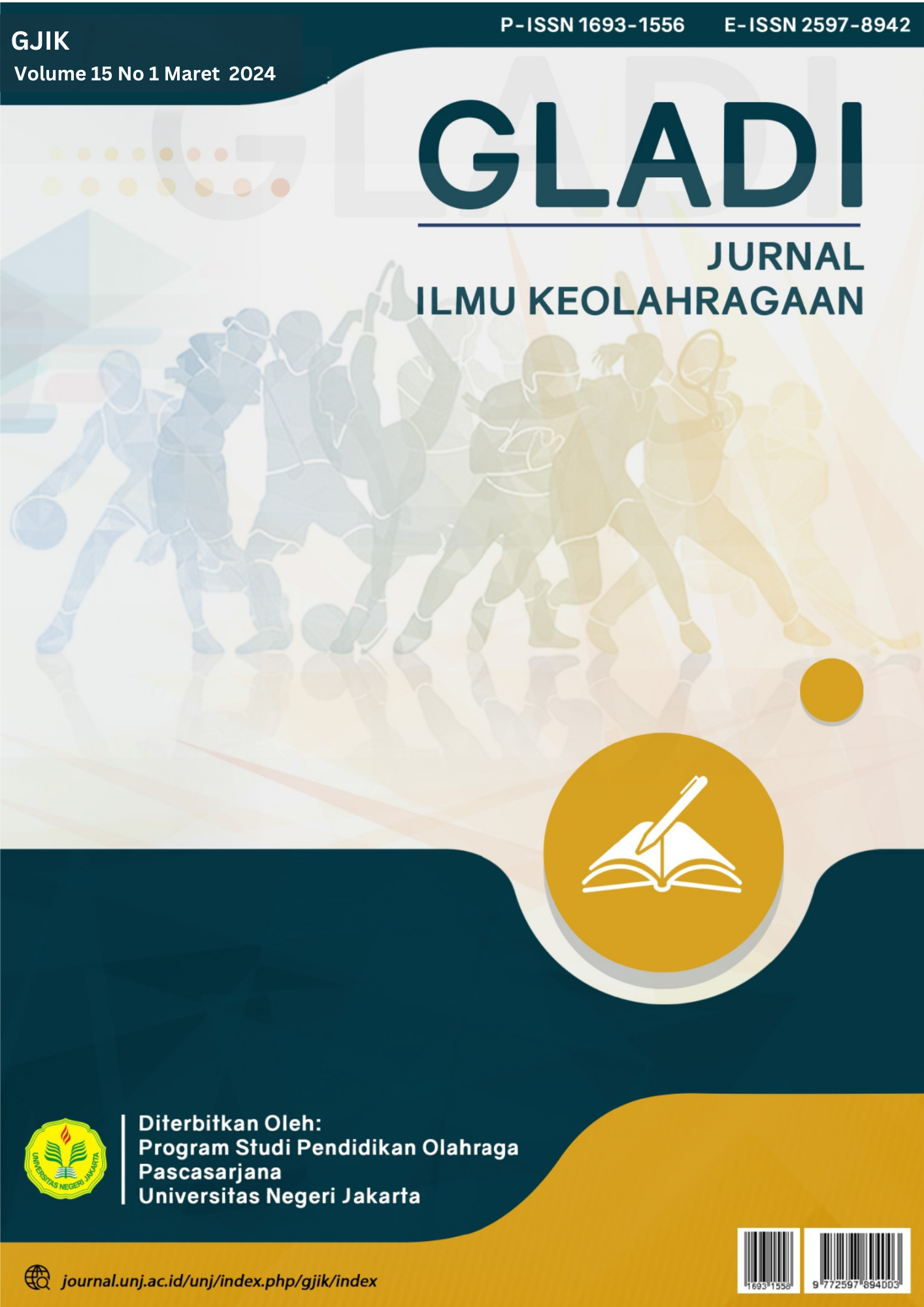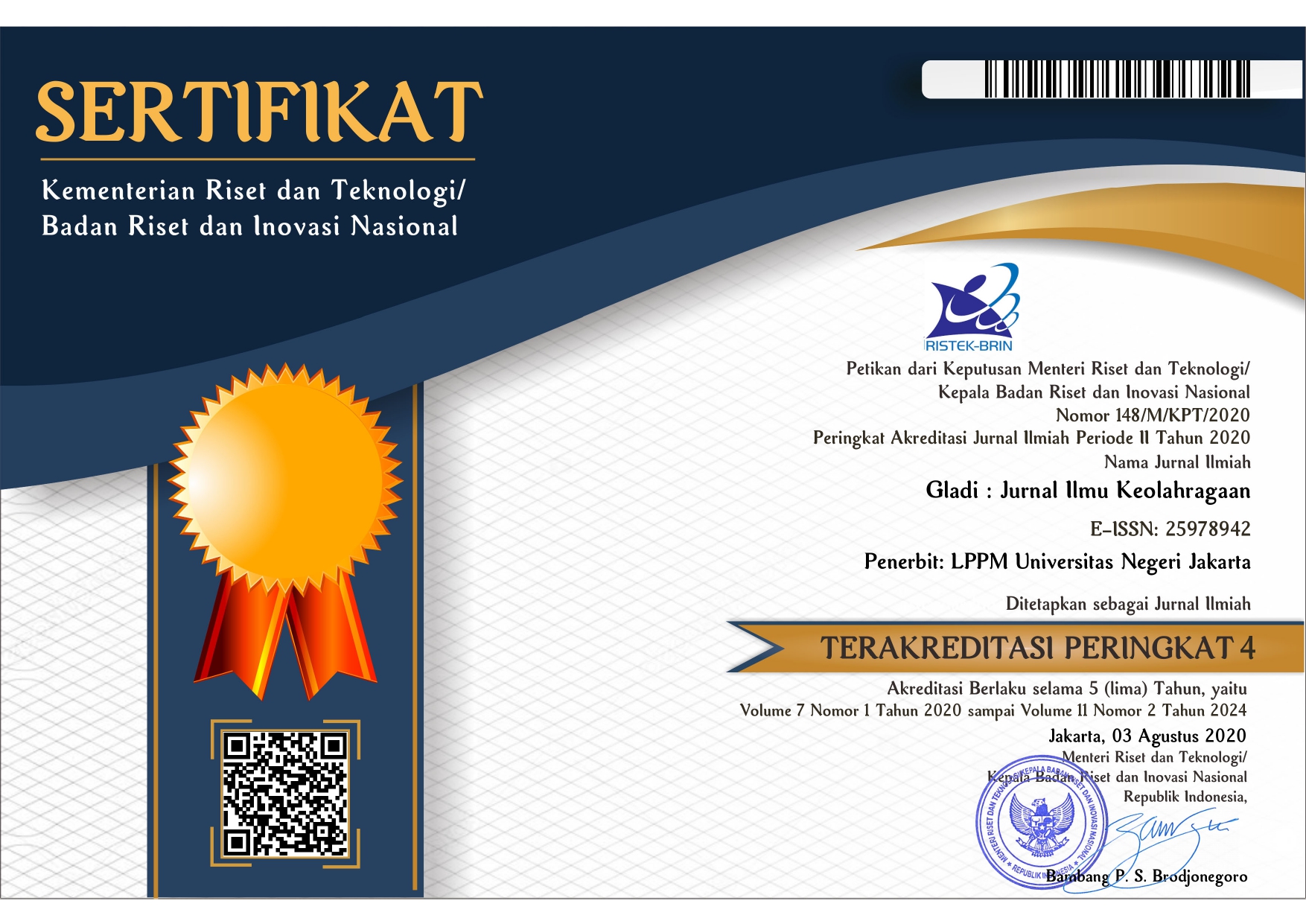ANALYSIS OF PHYSICAL ACTIVITY TO IMPROVE STUDENTS BASIC MOVEMENT SKILLS PHYSICAL LITERACY BASED PRIMARY SCHOOL
DOI:
https://doi.org/10.21009/GJIK.151.02Keywords:
Physical activity; basic movement abilities; Physical LiteracyAbstract
Abstract This literature review study is based on this The current education pattern cannot accommodate the needs of each individual to grow optimally. Most current education patterns do not provide enough space for students' uniqueness in carrying out physical activities. Mastery of basic movements needs to be given to children in the form of physical activity. Physical activity that is designed needs to increase and stimulate children to move without compulsion. The physical activity provided can be in the form of Physical Literacy . The literature review method was carried out on three articles obtained from a number of databases, PubMed, EBSCO, and Springer Link. Keywords for searching articles are physical activity, physical literacy , basic movement skills, physical literacy . Researchers use "AND" as a Boolean operator. The results of the literature review are that the development of a physical activity model to improve elementary school students' basic movement skills is based on physical literacy. The results of the review article are: 1) Physical activity improves health, 2) Good physical literacy knowledge in children aged 7-12 years, 3) Developing physical literacy. The conclusion from the literature review is that understanding physical activity based on the concept of physical literacy can improve health. A high understanding of physical literacy is related to the holistic development of children aged 7-12 years, namely if a person's body is healthy then they will grow and develop optimally. Traditional games can develop elementary school students' physical literacy. These results are based on the improvement achieved by students in the aspects of understanding how to perform movements, movement skills and enjoyment.
Keywords: Physical activity, basic movement abilities and Physical Literacy
Downloads
References
Akbari, H., Abdoli, B., Shafizadeh, M., Khalaji, H., Haji, H.S., & Ziaei, V. (2009). The effect of traditional games on fundamental motor skill development in 7-9 year-old boys. 123–129. https://doi.org/10.1080/02701367.2016.1164009.
Butler, J., & Griffin, L. (2010). More teaching games for understanding: Moving globally. Human Kinetics.
Byl, J., & Kloet, B. V. (2014). Physical education for homeschool, classroom, and recreation settings: 102 games with variations. Human Kinetics.
Castelli, D.M., Centeio, E.E., Beighle, A.E., Carson, R.L., & Nicksic, H.M. (2014). Physical literacy and comprehensive school physical activity programs. Preventive Medicine, 66, 95–100. https://doi.org/10.1016/j.ypmed.2014.06.007.
Coker, C. A. (2017). Motor learning and control for practitioners. New York: Routledge.
Corbin, C. B. (2016). Implications of physical literacy for research and practice: A commentary. Research Quarterly for Exercise and Sport, 87(1), 14–27. https://doi.org/10.1080/02701367.2016.1124722.
Domville, M., Watson, P. M., Richardson, D., & Graves, L. E. F. (2019). Children's perceptions of factors that influence PE enjoyment: a qualitative investigation. Physical Education and Sport Pedagogy, 1–13. https://doi.org/10.1080/17408989.2018.1561836.
Edwards, L.C., Bryant, A.S., Keegan, R.J., Morgan, K., & Jones, A.M. (2017). Definitions, foundations and associations of physical literacy: a systematic review. Sports Medicine, 47(1), 113–126. https://doi.org/10.1007/s40279-016-0560-7.
Fedewa, A.L., & Ahn, S. (2011). The effects of physical activity and physical fitness on children's achievement and cognitive outcomes: a meta-analysis. Research Quarterly for Exercise and Sport, 82(3), 521–535. https://doi.org/10.1080/02701367.2011.10599785.
Gelisli, Y., & Yazici, E. (2015). A study into traditional child games played in Konya region in terms of development fields of children. Procedia-Social and Behavioral Sciences, 197, 1859–1865. https://doi.org/10.1016/j.sbspro.2015.07.247.
Giblin, S., Collins, D., & Button, C. (2014). Physical literacy: importance, assessment and future directions. Sports Medicine, 44(9), 1177– 1184. https://doi.org/10.1007/s40279-014-0205-7.
Goodway, J.D., Ozmun, J.C., & Gallahue, D.L. (2019). Understanding motor development: Infants, children, adolescents, adults. Jones & Bartlett Learning.
Hanief, YN, & Sugito, S. (2015). Forming basic movements in elementary school students through traditional games. SPORTIF Journal: Journal of Learning Research, 1(1), 100–113. https://doi.org/10.29407/js_unpgri.v1i1.575.
Higgs, C., Balyi, I., Way, R., Cardinal, C., Norris, S., & Bluechardt, M. (2008). Developing physical literacy: A guide for parents of children ages 0 to 12. Vancouver, BC: Canadian Sports Centres.
Irmansyah, J., Lumintuarso, R., Sugiyanto, FX, & Sukoco, P. (2020). Children's social skills through traditional sports games in primary schools. Journal of Educational Horizons, 39(1), 39–53. https://doi.org/10.21831/cp.v39i1.28210.
Kovar, S. K. (2012). Elementary classroom teachers as movement educators. McGraw-Hill Companies.
Kurniati, E. (2016). Traditional Games and Their Role in Developing Children's Social Skills. Jakarta: Kencana.
Lambrick, D., Westrupp, N., Kaufmann, S., Stoner, L., & Faulkner, J. (2016). The effectiveness of a high-intensity games intervention on improving indices of health in young children. Journal of Sports Sciences, 34(3), 190–198. https://doi.org/10.1080/02640414.2015.1048521.
Lavega, P., Alonso, J.I., Etxebeste, J., Lagardera, F., & March, J. (2014). Relationship between traditional games and the intensity of emotions experienced by participants. Research Quarterly for Exercise and Sport, 85(4), 457–467. https://doi.org/10.1080/02701367.2014.961048.
Lobstein, T., Jackson-Leach, R., Moodie, M.L., Hall, K.D., Gortmaker, S.L., Swinburn, B.A., ... McPherson, K. (2015). Child and adolescent obesity: part of a bigger picture. The Lancet, 385(9986), 2510– 2520. https://doi.org/10.1016/S0140-6736(14)61746-3.
Lundvall, S. (2015). Physical literacy in the field of physical education–A challenge and a possibility. Journal of Sport and Health Science, 4(2), 113–118. https://doi.org/10.1016/j.jshs.2015.02.001.
Nur, H. (2013). Building children's character through traditional children's games. Journal of Character Education, (1). https://doi.org/10.21831/jpk.v0i1.1290.
Pagani, L. S., Fitzpatrick, C., & Barnett, T. A. (2013). Early childhood television viewing and kindergarten entry readiness. Pediatric Research, 74(3), 350–355. https://doi.org/10.1038/pr.2013.105.
Payne, V. G., & Isaacs, L. D. (2017). Human motor development: A lifespan approach. Routledge.
Perdani, PA (2013). Improving social skills through traditional game playing methods in kindergarten B children. Journal of Early Childhood Education, 7(2), 234–250. https://doi.org/10.21009/JPUD.072.10.
Roetert, E. P., & MacDonald, L. C. (2015). Unpacking the physical literacy concept for K-12 physical education: What should we expect the learner to master? Journal of Sport and Health Science, 4(2), 108– 112. https://doi.org/10.1016/j.jshs.2015.03.002.
Santrock, J. W. (2014). Essentials of life-span development. McGraw-Hill.
Silverman, S., & Mercier, K. (2015). Teaching for physical literacy: Implications for instructional design and PETE. Journal of Sport and Health Science, 4(2), 150–155. https://doi.org/10.1016/j.jshs.2015.03.003.
Spinath, B., & Spinath, F. M. (2005). Development of self-perceived ability in elementary school: The role of parents' perceptions, teacher evaluations, and intelligence. Cognitive Development, 20(2), 190– 204. https://doi.org/10.1016/j.cogdev.2005.01.001.
Suherman, WS, Dapan, D., Guntur, G., & Muktiani, NR (2019). Development of a traditional children game based instructional model to optimize kindergarteners' fundamental motor skills. Journal of Educational Horizons, 38(2), 356–365. https://doi.org/10.21831/cp.v38i2.25289.
Sun, H. (2015). Operationalizing physical literacy: the potential of active video games. Journal of Sport and Health Science, 4(2), 145–149. https://doi.org/10.1016/j.jshs.2015.03.006.
Tandon, P.S., Tovar, A., Jayasuriya, A.T., Welker, E., Schober, D.J., Copeland, K., ... Ward, D.S. (2016). The relationship between physical activity and diet and young children's cognitive development: A systematic review. Preventive Medicine Reports, 3, 379–390. https://doi.org/10.1016/j.pmedr.2016.04.003.
Tremblay, M., & Lloyd, M. (2010). Physical literacy measuring the missing piece. Physical & Health Education Journal, 76(1), 26-30.
Whitehead, M. (2013). Stages in the physical literacy journey. ICSSPE Bulletin–Journal of Sport Science and Physical Education, 65. Retrieved from http://www.icsspe.org/sites/default/files/bulletin65_0.pdf#page=29. Accessed January 13, 2020.
WHO. (2014). Commission on Ending Childhood Obesity holds hearing with non-state actors. Geneva (CH): World Health Organization; 2014.
Wijaya, EY, Sudjimat, DA, & Nyoto, A. (2016). Transformation of 21st century education as a demand for human resource development in the global era. Proceedings of the National Seminar on Mathematics Education, 1(26), 263–278.
Williams, H.G., Pfeiffer, K.A., O'neill, J.R., Dowda, M., McIver, K.L., Brown, W.H., & Pate, R.R. (2008). Motor skill performance and physical activity in preschool children. Obesity, 16(6), 1421–1426. https://doi.org/10.1038/oby.2008.214







